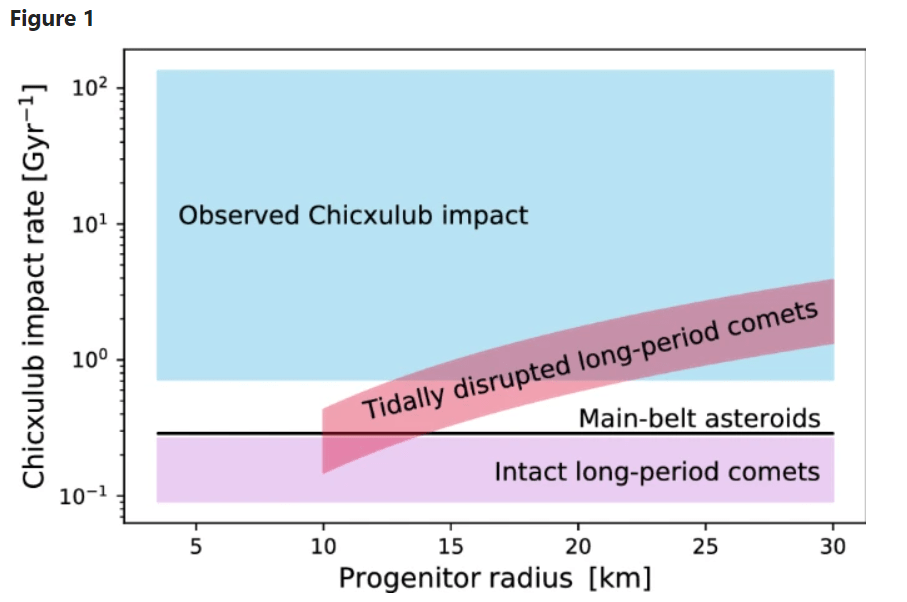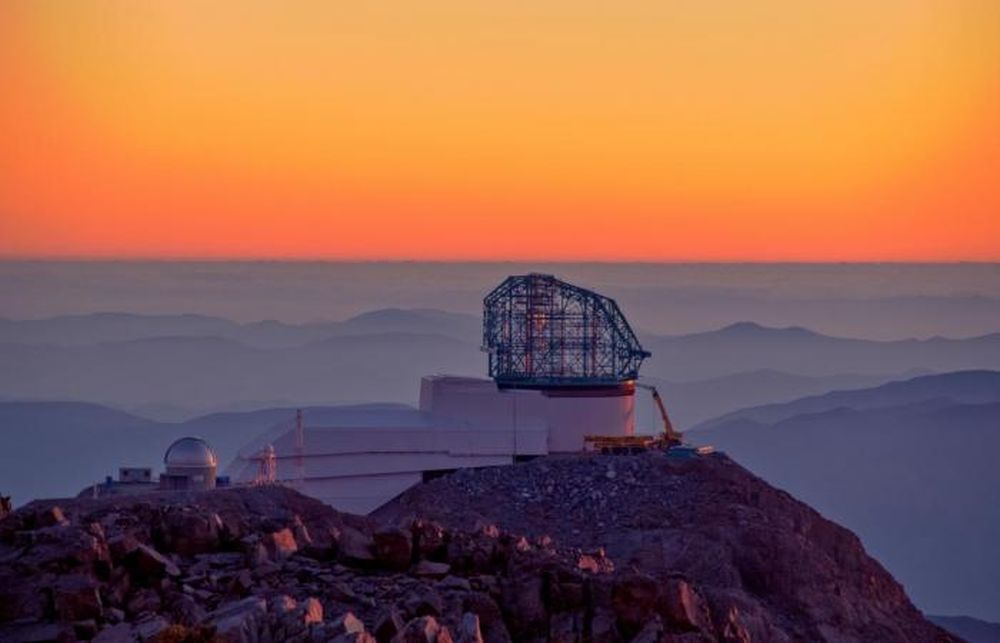Did a Comet Wipe out the Dinosaurs?
By Evan Gough
About 66 million years ago a massive chunk of rock slammed into Earth in what is the modern-day Yucatan Peninsula. The impact extinguished about 75% of all life on Earth. Most famously, it was the event that wiped out the dinosaurs.
While mainstream scientific thought has pointed to an asteroid as the impactor, a new research letter says it could’ve, in fact, been a comet.
The Chicxulub impactor, as it’s known, excavated a crater 150 km (93 mi) in diameter and about 20 km (12 mi) deep. The impact had a devastating effect. There was a tsunami, global wildfires, and an immediate greenhouse effect followed by a prolonged period of cooler temperatures. Researchers are still trying to piece it all together.
One question still isn’t settled: Was the Chicxulub impactor an asteroid, or a comet? A new study says that it was a comet.

The study is titled “Breakup of a long-period comet as the origin of the dinosaur extinction.” The authors are Harvard University astrophysics undergraduate student Amir Siraj and well-known Harvard Astronomy Professor Avi Loeb. The paper is published in Nature’s Scientific Reports.
Previous research has suggested that the impactor was an asteroid from the main belt. But some of the evidence puts that conclusion in doubt. Evidence at the impact site suggests that the impactor was a carbonaceous chondrite. But those types of asteroids are rare in the main belt. They may make up only about 10% of the asteroids there.
In the Oort Cloud, however, carbonaceous chondrite material could be widespread.
The Oort Cloud is the home of long-period comets, comets with orbital periods exceeding 200 years. Some of those long-period comets can be gravitationally perturbed by Jupiter and thrown off course.

“The solar system acts as a kind of pinball machine,” explained Siraj in a press release. “Jupiter, the most massive planet, kicks incoming long-period comets into orbits that bring them very close to the sun.”
Astronomers call those comets “sun-grazers.” Sun-grazers can have very close encounters with the Sun, and that spells trouble. The Sun’s powerful gravity can rip them apart, resulting in a shower of shrapnel-like chunks. With so many pieces, there’s an increased chance of collision with a planet.
“In a sungrazing event, the portion of the comet closer to the sun feels a stronger gravitational pull than the part that is further, resulting in a tidal force across the object,” Siraj says. “You can get what’s called a tidal disruption event, in which a large comet breaks up into many smaller pieces. And crucially, on the journey back to the Oort cloud, there’s an enhanced probability that one of these fragments hit the Earth.”

The pair of scientists used statistical analysis and gravitational simulations in their work. They found that Jupiter’s gravity could perturb a significant number of Oort Cloud comets and send them closer toward the Sun. Their calculations show that it’s ten times more likely for one of these comets, or their fragments, to hit Earth than previously thought. Their work also shows that about 20 percent of long-period comets could be Sun-grazers.
Loeb and Siraj say that their calculations line up well with the timing of the Chicxulub impact. They say that their work explains that impact and could also explain the origin of other impactors in the Solar System.
“Our paper provides a basis for explaining the occurrence of this event,” Loeb said. “We are suggesting that, in fact, if you break up an object as it comes close to the sun, it could give rise to the appropriate event rate and also the kind of impact that killed the dinosaurs.”
Siraj and Loeb say that their long-period comet solution also explains some other impacts on Earth.
Though the Chicxulub impact was an enormously cataclysmic event that shaped the course of life on Earth, it didn’t leave the largest crater. The largest impact crater on Earth is the Vredefort crater in South Africa. It’s 300 km (190 mi) in diameter and was created when an impactor struck Earth a little over two billion years ago.
![The Vredefort crater dome as seen from space on the STS-51-I mission. It was created by the impact of a large object about two billion years ago. The new research letter claims it could be the result of a long-period comet ripped apart by the Sun's tidal forces, with one of the fragments striking Earth. By Júlio Reis (User:Tintazul) - [1], Public Domain, https://commons.wikimedia.org/w/index.php?curid=400487](https://www.universetoday.com/wp-content/uploads/2021/02/716px-Vredefort_Dome_STS51I-33-56AA.jpg)
There’s also the Zhamanshin crater in Kazakhstan. It’s 14 km (8.7 mi) in diameter and was created by an impact about one million years ago. The Zhamanshin impact was the most recent impact event that was large enough to create a nuclear winter. However, it wasn’t large enough to cause a mass extinction.
Loeb and Siraj say that their fragmented-comet hypothesis could also explain both of these impacts. Their study shows that a Chicxulub-range LPC should strike Earth every ?250?730 Myr and that smaller fragments from one that was tidally-disrupted should strike Earth about every ?0.25?0.73 Myr.
Their hypothesis requires testing, though. The authors say that further study of these three craters and others like them will help strengthen or weaken the hypothesis. Ideally, the pair say, examining craters on the Moon would also help. And comet-sampling missions could also contribute.
More focused observations of comets could help, too. The upcoming Vera Rubin Observatory will be especially effective at spotting transient and variable events, including asteroids and comets that move through the inner Solar System. If long-period comets get perturbed by Jupiter’s gravity and sent towards the Sun, only to be torn apart by tidal forces, then the Vera Rubin should be able to spot them. It should also see any fragments sent towards Earth.

“We should see smaller fragments coming to Earth more frequently from the Oort cloud,” Loeb says. “I hope that we can test the theory by having more data on long-period comets, get better statistics, and perhaps see evidence for some fragments.”
If the pair’s hypothesis proves to be accurate, the implications may be serious. It means that we can expect a long-period comet to disintegrate in the inner Solar System again and that Earth could be in harm’s way. Fortunately, we’re getting better at watching for these potential impactors and are even working out ways to prevent a catastrophic impact.
But for now, at least, the hypothesis sheds light on a critical event in Earth’s history. An event that would’ve been truly awesome to witness. From a safe distance.
“It must have been an amazing sight, but we don’t want to see that again,” Loeb said.
More:
- Press Release: Comet or Asteroid: What Killed the Dinosaurs And Where Did it Come From?
- Research Article: Breakup of a long-period comet as the origin of the dinosaur extinction
- Universe Today: When Comets Break Up, the Fragments Can Be Devastating If They Hit the Earth
The post Did a Comet Wipe out the Dinosaurs? appeared first on Universe Today.

February 20, 2021 at 01:20AM
via Universe Today read more...

Post a Comment